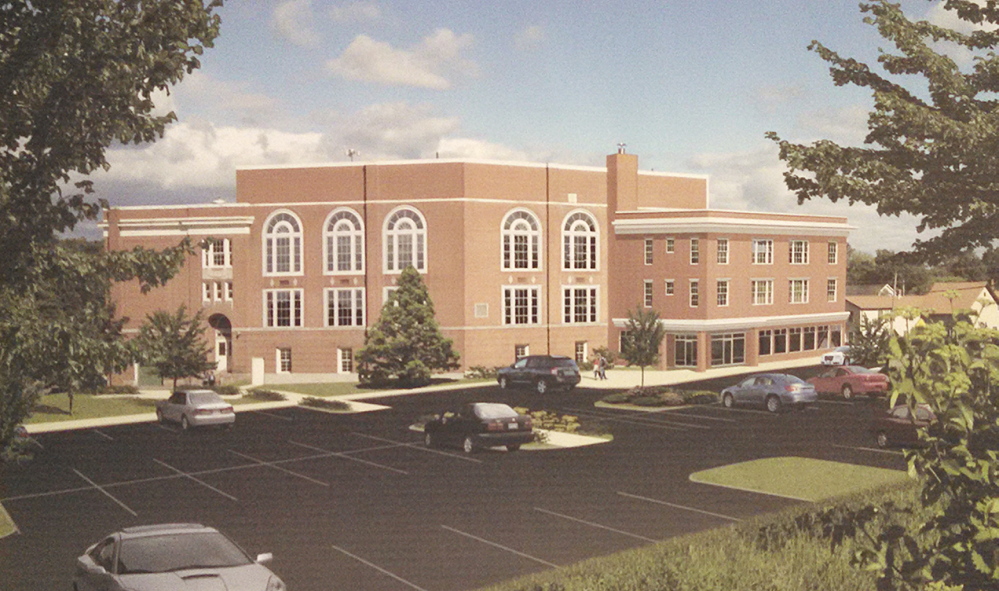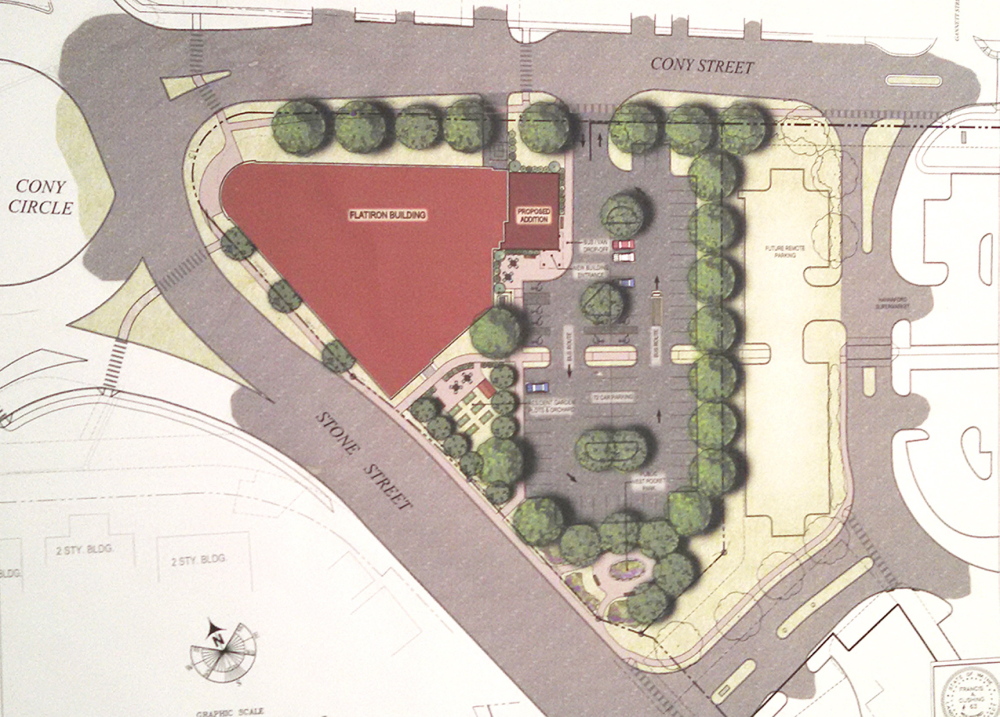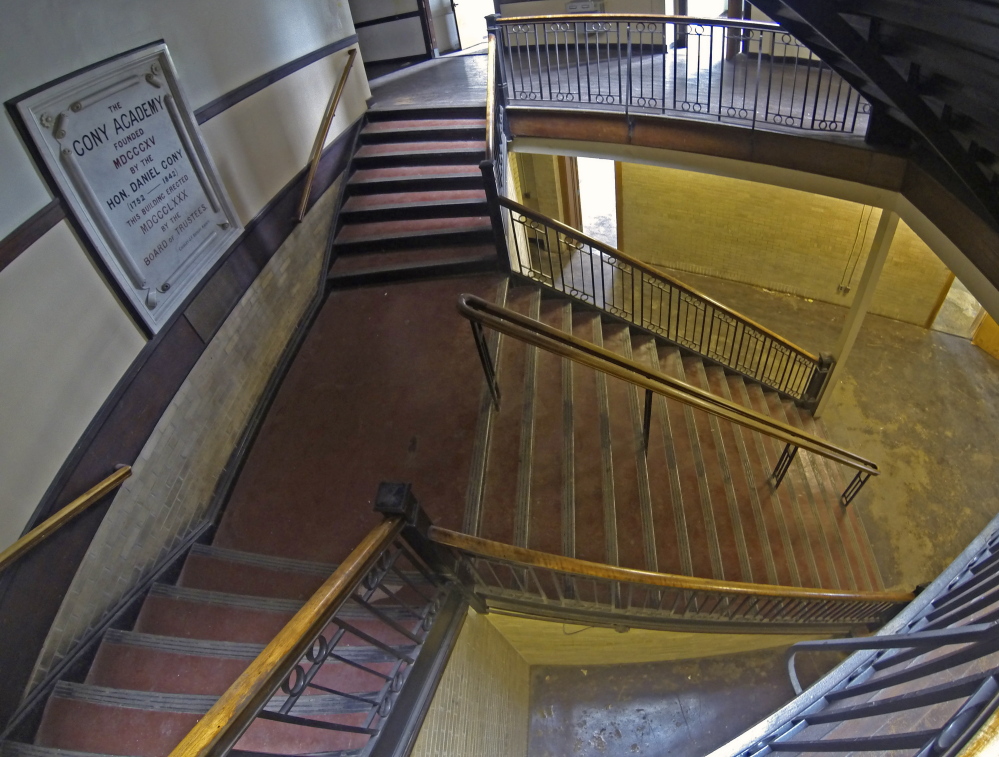AUGUSTA — After 76 years of thousands of students filling its classrooms and hallways and eight more years of sitting empty and unused, the Cony High School flatiron building is no longer under local government’s direct control.
Cynthia Taylor, president of Housing Initiatives of New England, plans to turn the former high school building into low-income housing for senior citizens. She closed a deal this week with the city for a long-term lease of the building on Cony Circle on the city’s east side.
A small crew brought in tools and ladders Friday to prepare to start an $11 million project to turn the brick building’s high-ceilinged classrooms and sweeping staircases into 48 apartments for elders. Apartments should be ready to rent in May of 2015.
“It’s going to be a marathon to get everything addressed and taken care of and bring this building back to life,” Taylor said. “We’ve already been hearing from people (expressing interest in living there), we’ve got about a dozen names on the list.”
Taylor, who in 2000 redeveloped the nearby former city hall in Augusta into the Inn at City Hall, 31 assisted-living apartments, has a 49-year-lease for the fee of $1 a year.
City officials, before reaching a deal with Taylor, tried four times to find a developer willing to take on the project and find a new use for the old school. The city wanted someone willing to preserve the building’s exterior structure and some of the interior, including its ornate but neglected auditorium.
The city was spending about $75,000 a year to heat and maintain the building, which had been empty since the end of the 2006 school year.
The deal with Taylor essentially gives her company control over the still city-owned building.
“Technically speaking, it’s a lease, but it is for such a long term, it is the equivalent of a sale,” said City Manager William Bridgeo. “The property is now in the hands of the most-capable Cyndy Taylor. We’re taking it off our insurance. We’ve ceased any maintenance contracts, no more fuel is being delivered there by us.”
A market study done for the project indicated not enough senior citizen rental properties have been created in the city or region to keep up with the growth in the senior citizen population that needs housing. The study projected from 2013 to 2018 there will be a need for an additional 192 rental units for elders in the Augusta area.
“We have already had people walking into the housing authority wondering how and where they can apply to live at the new Cony flatiron,” said Amanda Bartlett, executive director of the Augusta Housing Authority. “There is a buzz out there in the senior community around these old schools. Schools are very nostalgic places, people can’t wait to live there.”
Bartlett said schools are especially attractive because they are “typically in town and provide easy access to grocery stores, medical offices, downtown and amenities.”
The Augusta Housing Authority is not involved in the flatiron project, but is in the beginning stages of its own school redevelopment project in Augusta. It plans to convert the former Hodgkins Middle School building, just a half-mile up the hill from the flatiron building, into as many as 47 rental units, also for senior citizens.
Bartlett said that project is progressing and she hopes to have Hodgkins listed on the National Register of Historic Places so it can qualify for historic preservation tax credits. If efforts to secure financing and permits for the Hodgkins project move forward, Bartlett said, construction could start in the summer or fall of 2015 and it could open in 2016.
Bartlett and Taylor said there is room, and enough demand for senior housing, for both projects.
“They assured me they won’t be competing with me in the startup phase, the first year,” Taylor said. “I think we’ll prove the market, one way or another. It is always my intent to work with local housing authorities.”
Bartlett anticipated the flatiron will be full by the time Hodgkins opens.
Taylor praised city officials for their help with the project.
Much of the flatiron project is being financed with historic preservation and housing tax credits provided by Maine State Housing Authority. It is also using $580,000 in grant money from the Federal Home Loan Bank of San Francisco, and $250,0000 in state Community Development Block Grant funds.
To qualify for tax credits, Taylor established a for-profit arm of the otherwise non-profit organization Housing Initiatives of New England to develop the flatiron project.
The city also granted a tax increment financing deal to assist the project, returning 100 percent of the property taxes to the developer.
Bridgeo said the tax financing from the city was a part of the financial package required to make renovating the old school into housing feasible for Taylor. He noted if the project were developed by a non-profit organization, the city wouldn’t be paid property taxes on it, anyway.
Taylor said the building will have seven two-bedroom units and 41 one-bedroom units, a yoga room, cafe for residents, resident gardens, patio and performing arts space.
Preserving that performing arts space — the school auditorium — was something sought by many advocates for the old building, including Mary Mayo-Wescott, president of the since-disbanded Friends of the Flatiron group.
“This is a happy day for me,” Mayo-Wescott said. “I’m so glad Cyndy Taylor is going to carry this forth, she has a magnificent reputation. Two weeks ago we had a tour of the flatiron, and she showed us her vision. It sounds like it is going to be just wonderful.”
Taylor said anyone interested in an apartment in the building can call Stewart Property Management at 622-1014, or Housing Initiatives at 774-8812.
She said rents are expected to range between $780 and $950.
Several items of historical significance were left behind by the city. The city will retain ownership of them, and they will be preserved and kept in the building. They include the Daniel Cony clock and plaque in the front stairway of the building and two bronze plaques in the auditorium
Ledgewood Construction and CWS Architects, both from the Portland area, are working on the project for Taylor.
Taylor said the staircase will be preserved, as will all the corridors, the original entrances into the classrooms and the entry from the Cony Circle side of the building.
The windows will be replaced, Taylor said, and the new ones will closely match the original wooden windows, which are no longer on the building.
A new main entrance to the building will be created facing Stone Street and Hannaford supermarket, which was built when the newer section of the high school was torn down after the school closed.
In 2005, the city asked a Kennebec County Superior Court judge to lift restrictions on land given by Daniel Cony for the creation of the Cony Female Academy, which later became Cony High School. The city eventually was able to sell about six acres of the property, next to the flatiron building where the newer building, which opened in 1965, was. The land was sold for $1.5 million to Boulos Corp. and is now the Hannaford site.
Residents and descendants of Daniel Cony took legal action to try to stop the sale. Following a series of lawsuits, a judge ordered the city to use the $1.5 million in proceeds from the sale of the land adjacent to the flatiron building for educational purposes.
The city retained the flatiron building and officials vowed to seek a way to preserve the structure.
Keith Edwards – 621-5647
kedwards@centralmaine.com
Twitter: @kedwardskj
Send questions/comments to the editors.






Comments are no longer available on this story